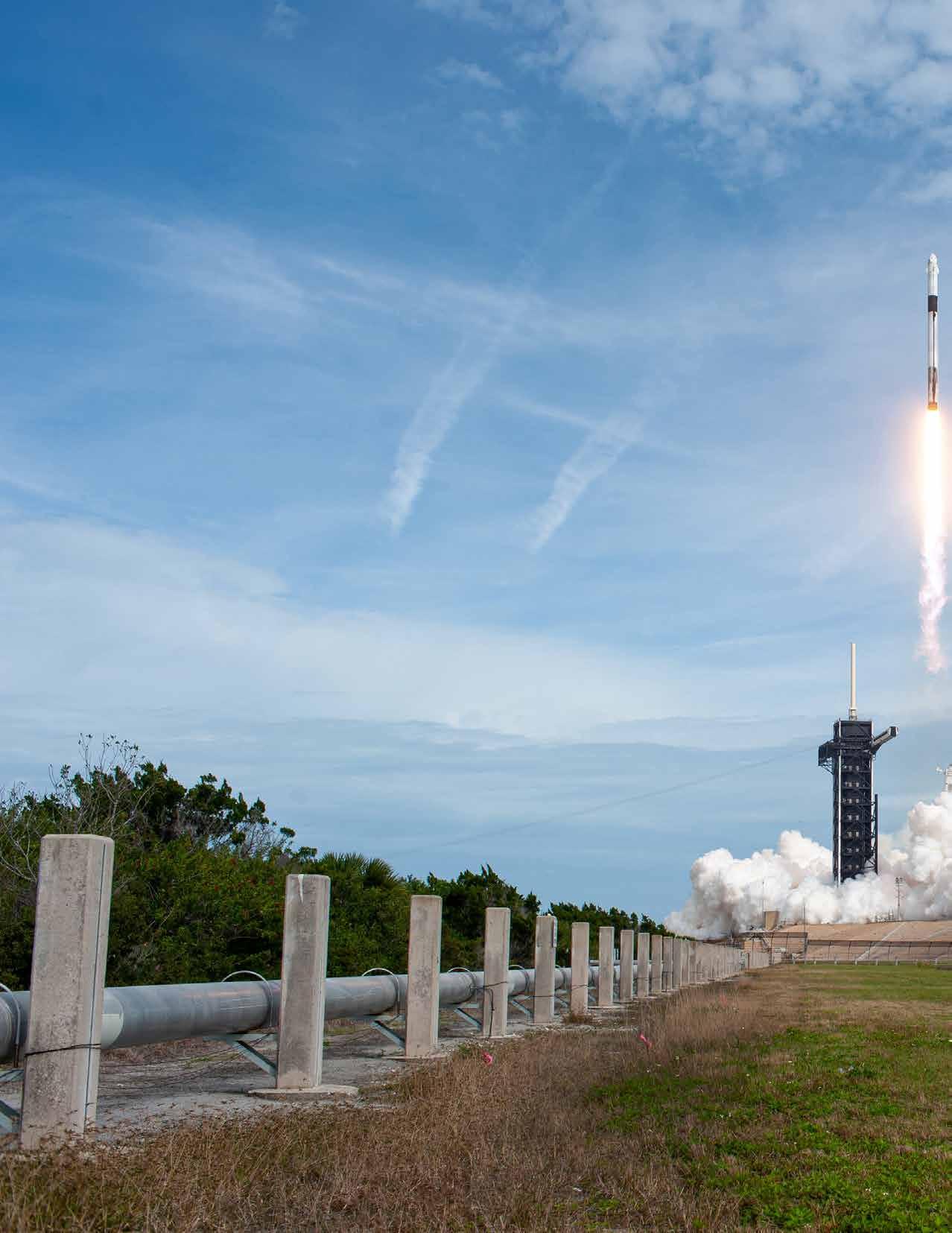
27 minute read
SpaceX In-Flight Abort Test complete
Launch Escape
NASA, SpaceX Successfully Complete Critical In-Flight Abort Test
Advertisement
BY JIM CAWLEY N ASA and SpaceX completed a launch escape demonstration of the company’s Crew Dragon spacecraft and Falcon 9 rocket Sunday, Jan. 19. This was the final major flight test of the spacecraft before it begins carrying astronauts to the International Space Station under NASA’s Commercial Crew Program. The launch escape test began at 10:30 a.m. EST with liftoff from historic Launch Complex 39A at NASA’s Kennedy Space Center in Florida on a mission to show the spacecraft’s capability to safely separate from the rocket in the unlikely event of an inflight emergency.
“Another amazing milestone is complete for our very soon-to-be project, which is launching American astronauts, on American rockets from American soil for the first time since the retirement of the Space Shuttle Program,” NASA Administrator Jim Bridenstine said during Sunday’s post-test news conference at Kennedy. “Congratulations to SpaceX and the entire NASA team on this final major flight milestone that we needed to accomplish. By all accounts, this was a very successful test.”
As part of the test, SpaceX configured Crew Dragon to trigger a launch escape about 1.5 minutes after liftoff. All major functions were executed, including separation, engine firings, parachute deployment and landing. Crew Dragon splashed down at 10:38 a.m. just off the Florida coast in the Atlantic Ocean.
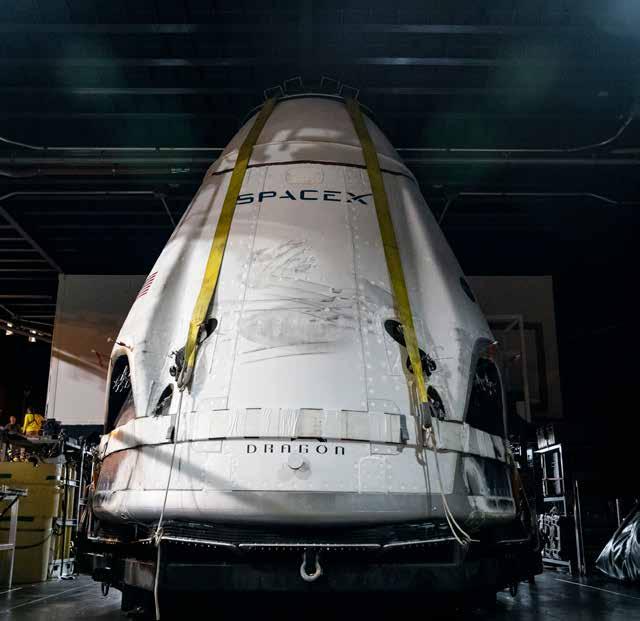
The SpaceX Crew Dragon spacecraft is offloaded from the company’s recovery ship, Go Searcher, at the Port Canaveral Army wharf in Florida, carrying the company’s Crew Dragon spacecraft following the uncrewed In-Flight Abort Test, Jan. 19, 2020. The flight test, which concluded with the Crew Dragon’s planned splashdown in the Atlantic Ocean, demonstrated the spacecraft’s escape capabilities in preparation for crewed flights to the International Space Station as part of the agency’s Commercial Crew Program. Photo credit: SpaceX
“As crew members, our families, you can imagine, are very interested in these escape systems and how well they work,” said NASA Astronaut Mike Hopkins, who viewed the test from Kennedy’s Launch Control Center firing room. “And so we’re going to be following very closely as the data comes in and we continue to analyze it.
“We’re excited where we are right now; we’re excited to continue training to finish up the testing and get ready for launch.”
Prior to the flight test, teams completed launch day procedures for the first crewed flight test, from suit-up to launch pad operations. The joint teams now will begin the full data reviews that need to be completed prior to NASA astronauts flying the system during SpaceX’s Demo-2 mission.
According to Elon Musk, SpaceX’s chief engineer, Crew Dragon’s peak velocity was double the speed of sound, or Mach 2.2, and achieved an altitude of 131,000 feet.
“I think these are very exciting specs for this abort to have gone more than three times the altitude of a typical airliner and to accelerate that rapidly away from the booster,” Musk said.
Musk also pointed out that the spacecraft landed in the ocean through relatively high winds, which will aid in preparation for the upcoming Demo-2 crewed mission.
“Overall, as far as we can tell thus far, it is a picture-perfect mission; it went as well as one can possibly expect,” Musk said. “I’m super fired-up; this is really great. We’re looking forward to the next steps.”
NASA’s Commercial Crew Program is working with the American aerospace industry as companies develop and operate a new generation of spacecraft and launch systems capable of carrying crews to low-Earth orbit and the International Space Station. Commercial human space transportation to and from the station will provide expanded utility, additional research time and broader opportunities for discovery on the orbiting laboratory. The program also has the benefit of facilitating and promoting for America a vibrant economy in low-Earth orbit.
“This is an important step on a long journey,” NASA astronaut Victor Glover said of in-flight abort. “We’re looking forward to the data analysis and learning more about the test today and the recovery efforts. We’re grateful for all the hard work to get here and looking forward to the work that we have left to do.” NASA astronauts Doug Hurley, left, and Bob Behnken stand near Launch Pad 39A at the agency’s Kennedy Space Center in Florida on Jan. 17, 2020, during a dress rehearsal ahead of the SpaceX uncrewed In-Flight Abort Test. In the background, the company’s Falcon 9 rocket is topped by the Crew Dragon spacecraft. The flight test will demonstrate the spacecraft’s escape capabilities in preparation for crewed flights to the International Space Station as part of the agency’s Commercial Crew Program. Hurley and Behnken are slated to fly on the company’s first crewed mission, Demo-2. Photo credit: NASA/Kim Shiflett
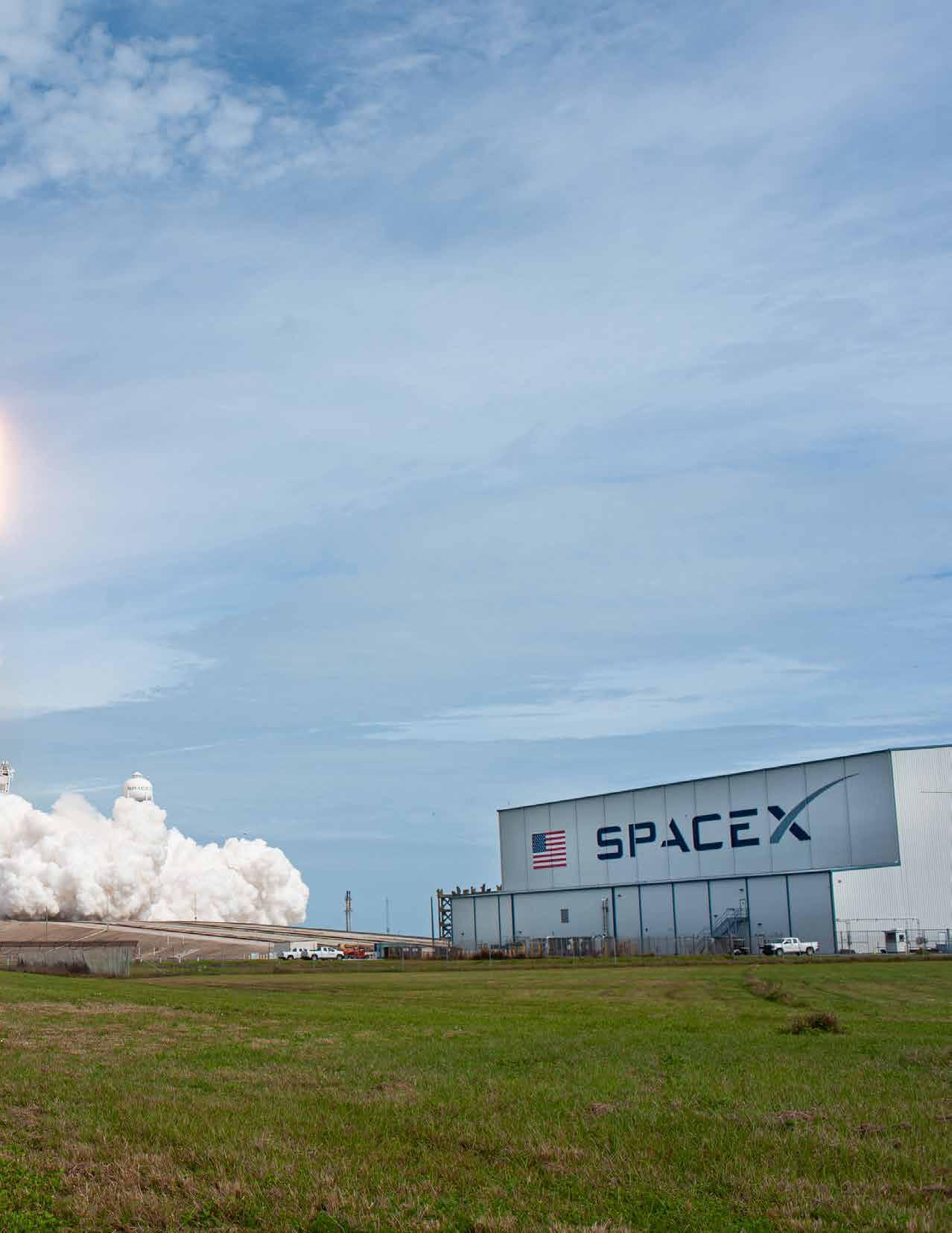
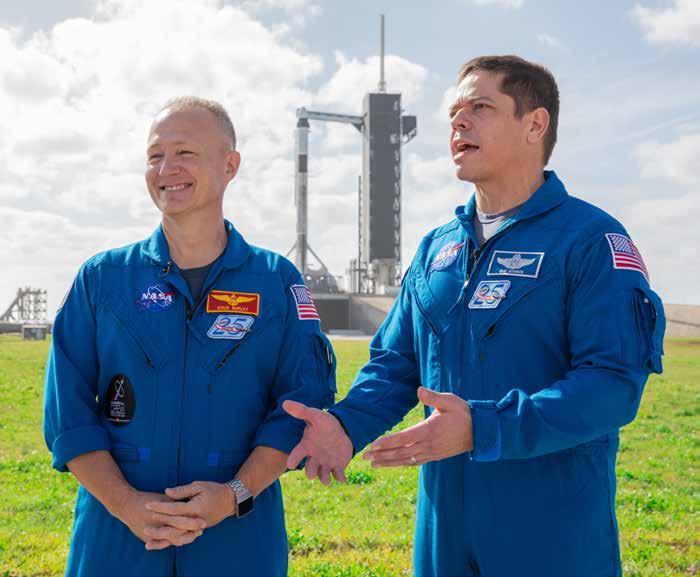
A SpaceX Falcon 9 rocket lifts off from Launch Complex 39A at NASA’s Kennedy Space Center in Florida at 10:30 a.m. EST on Jan. 19, 2020, carrying the Crew Dragon spacecraft on the company’s uncrewed In-Flight Abort Test. The flight test demonstrated the spacecraft’s escape capabilities in preparation for crewed flights to the International Space Station as part of the agency’s Commercial Crew Program. Photo credit: NASA/Tony Gray
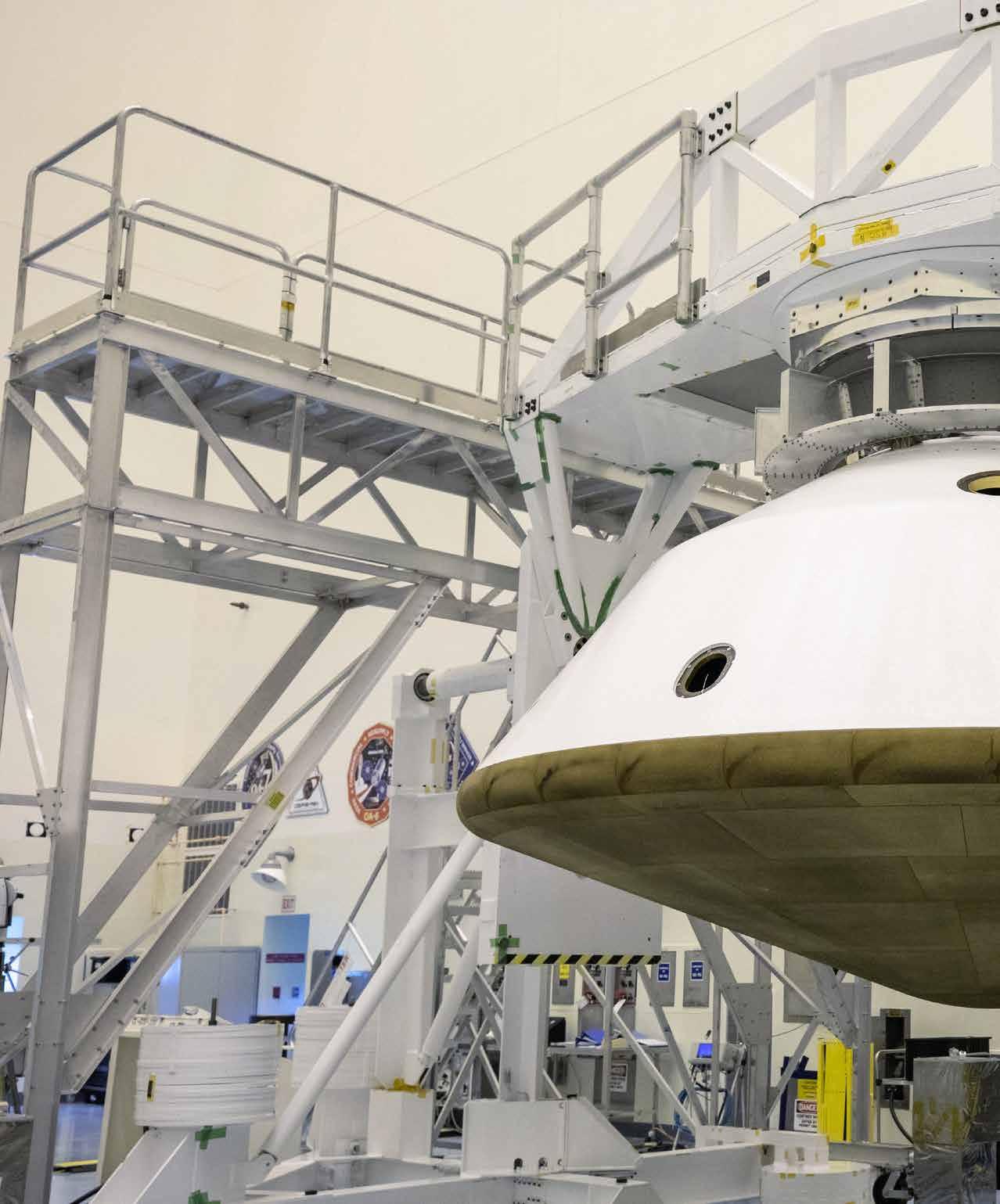

The Mars 2020 rover heat shield is mated to the back shell in the Payload Hazardous Servicing Facility at Kennedy Space Center on Jan. 10, 2020. Built by Lockheed Martin Space, the heat shield and back shell will protect the rover during its passage to Mars. The Mars 2020 rover was manufactured at NASA’s Jet Propulsion Laboratory in California and, once complete, was delivered to Kennedy on Feb. 12, 2020. The mission is scheduled to launch from Cape Canaveral Air Force Station in Florida in the summer of 2020. Photo credit: NASA/Kim Shiflett
HEATING UP
Solar Orbiter embarks on ambitious mission to face the Sun
BY ANNA HEINEY T he Solar Orbiter spacecraft is heading toward the Sun after a late-night launch on Sunday, Feb. 9, from Florida’s Space Coast aboard a United Launch Alliance (ULA) Atlas V rocket. The vehicle lifted off from Space Launch Complex 41 at Cape Canaveral Air Force Station at 11:03 p.m. EST.
After a nominal ascent, the spacecraft separated from the rocket’s Centaur upper stage. At 12:24 a.m. Monday, mission controllers at the European Space Operations Centre in Darmstadt, Germany, received a signal from the spacecraft indicating that its solar panels had successfully deployed and were drawing power.
“The spacecraft is safe and pointing to the Sun,” said European Space Agency’s (ESA) Cesar Garcia, program manager for Solar Orbiter.
Before the science phase of the mission can begin, Solar Orbiter will undergo a series of checkouts, from initial deployments and checks of the spacecraft’s systems to turning on and checking its suite of 10 science instruments. According to Garcia, the testing phase should be finalized around the end of June 2020.
Solar Orbiter is a cooperative mission between the ESA and NASA. ESA’s Engineering & Test Center (ESTEC) in The Netherlands managed the development effort. The spacecraft has been developed by Airbus. The European Space Operations Center (ESOC) in Germany will operate Solar Orbiter. The Solar Orbiter mission is managed by ESA; the scientific payload elements of Solar Orbiter are being provided by ESA Member States, NASA and ESA. United Launch Alliance of Centennial, Colorado, provided the Atlas V launch service. NASA Launch Director Tim Dunn of the agency’s Launch Services Program, which had responsibility for launch management, credited the combined efforts of the ULA, ESA and NASA teams to overcome challenges to make the launch successful.
“This is an international collaboration 10-plus years in the making,” Dunn said. “When a team is focused on mission success, that’s a language that we all speak.”
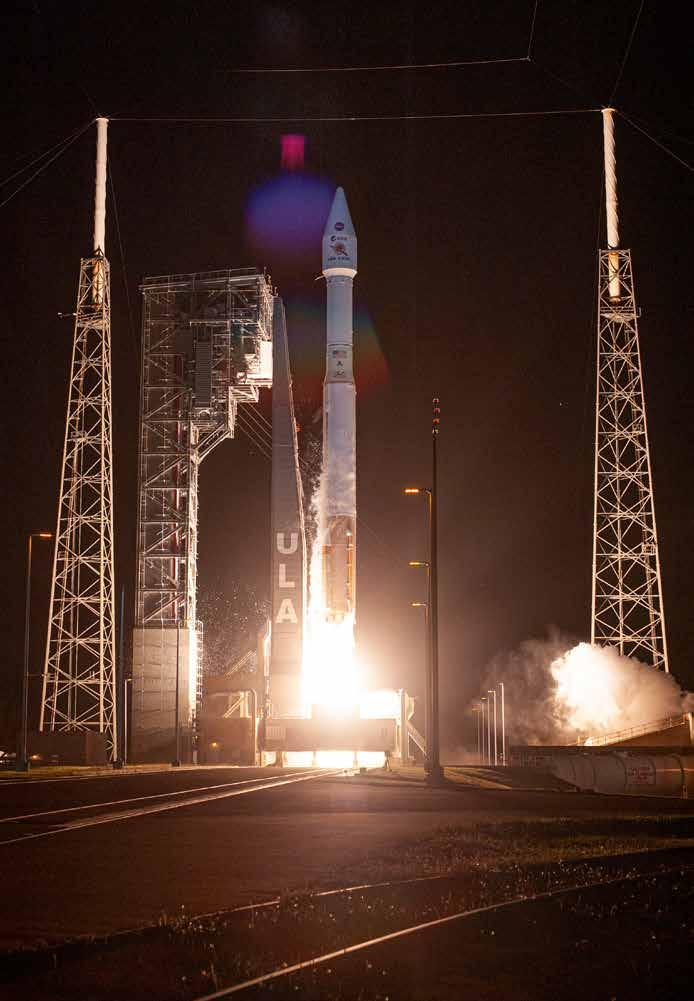
The United Launch Alliance Atlas V rocket, carrying the Solar Orbiter, lifts off Space Launch Complex 41 at Cape Canaveral Air Force Station in Florida at 11:03 p.m. EST, on Feb. 9, 2020. Photo credit: NASA/Tony Gray and Tim Terry
Solar Orbiter Media Day
Members of the media were given the opportunity to view and photograph the Solar Orbiter spacecraft up close inside the Astrotech Space Operations payload processing facility in Titusville, Florida, on Dec. 16, 2019.
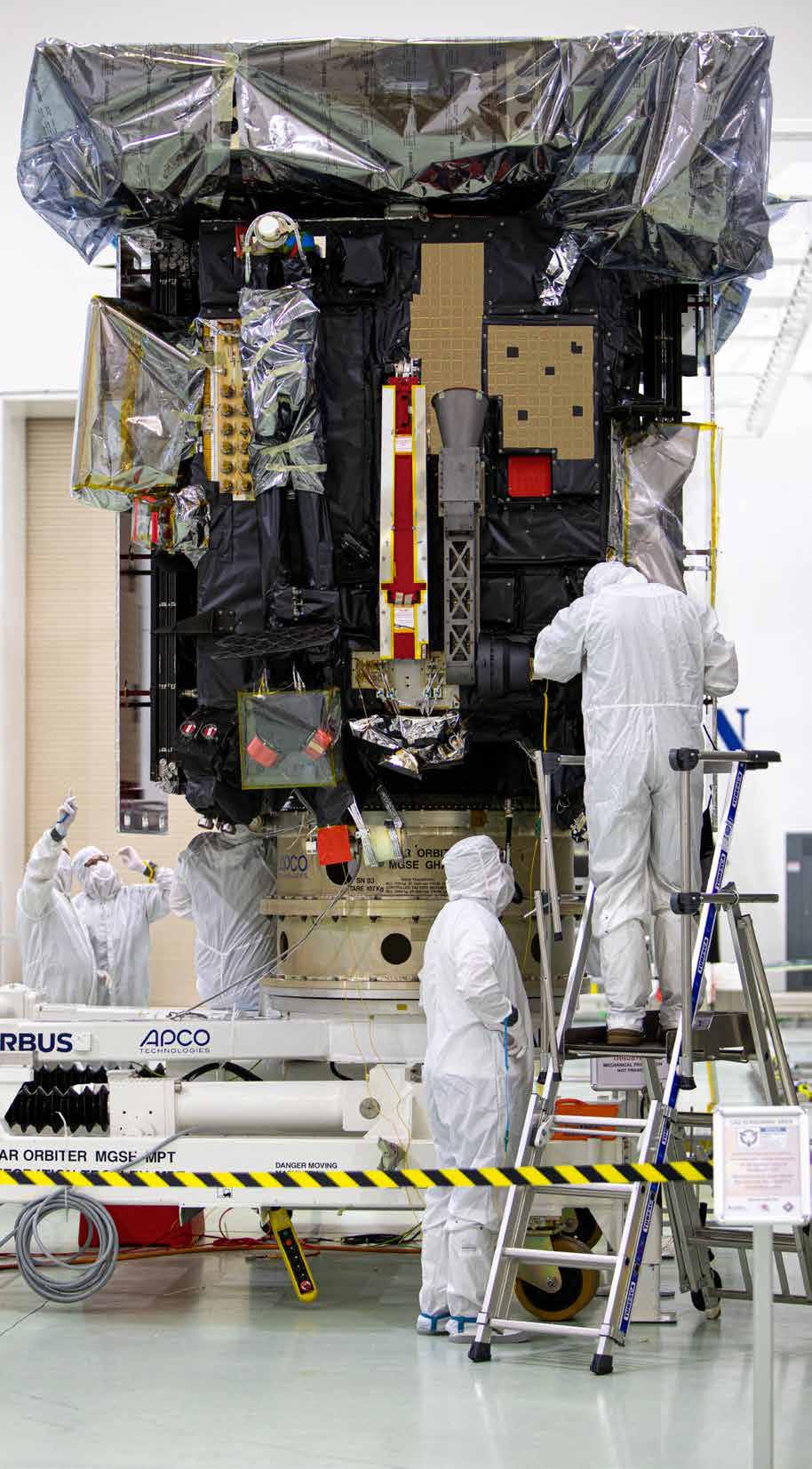
Representatives from NASA’s Launch Services Program (LSP), the European Space Agency (ESA), United Launch Alliance (ULA), Airbus Defence and Space, and NASA’s Goddard Space Flight Center provided an overview of the mission, spacecraft and launch vehicle. Solar Orbiter is a space mission of international collaboration between ESA and NASA, and the spacecraft was developed by Airbus.
The mission will study the Sun and how it can affect the space environment throughout the solar system, and it also will provide the first images of the Sun’s poles. Solar Orbiter launched from Cape Canaveral Air Force Station’s Space Launch Complex 41 aboard a ULA Atlas V rocket on Feb. 9, 2020. LSP managed the launch.
Photo credit: NASA/Frank Michaux

NASA Rings in Busy New Year in Florida to Prepare for Artemis Missions
BY LINDA HERRIDGE
NASA’s Kennedy Space Center in Florida will have a busy year preparing facilities, ground support equipment and space hardware for the launch of Artemis I, the first uncrewed launch of the Space Launch System (SLS) rocket and the Orion spacecraft. In 2020, Exploration Ground Systems (EGS) activities will ramp up as launch hardware arrives and teams put systems in place for Artemis I and II missions.
Launch Countdown Simulation Activities
Launch countdown simulations will continue to ramp up in 2020 to train and certify the launch control team for Artemis missions. The types of simulations will build on one another and will walk through the final portions of the launch countdown sequence, called the terminal countdown. Integrated simulations will tie in all NASA centers working the mission to ensure all members of the team are ready to work together, including Mission Control at Johnson Space Center in Houston, and the SLS Engineering Support Center at Marshall Space Flight Center in Alabama. Simulations will begin at the end of January and will occur up through one week before launch, with an average of one training exercise each month.
Vehicle Assembly Building
Much of the work in 2020 will be to complete a punch list of detail work inside the Vehicle Assembly Building (VAB). This includes cleaning the platforms and making minor repairs to any platform hardware that will be near flight hardware as the facility prepares for arrival of SLS components and stacking operations.
“We are at a very significant point in NASA’s Artemis mission,” said Mike Bolger, program manager of EGS. “The EGS team has finished mobile launcher testing at the launch pad and will finish testing at the VAB in January. At that point, all of the launch infrastructure will be tested and ready for operations.” Members of the Artemis I launch team monitor activities during the first formal terminal countdown simulation inside Firing Room 1 in the Launch Control Center at NASA’s Kennedy Space Center in Florida. Photo credit: NASA/Kim Shiflett
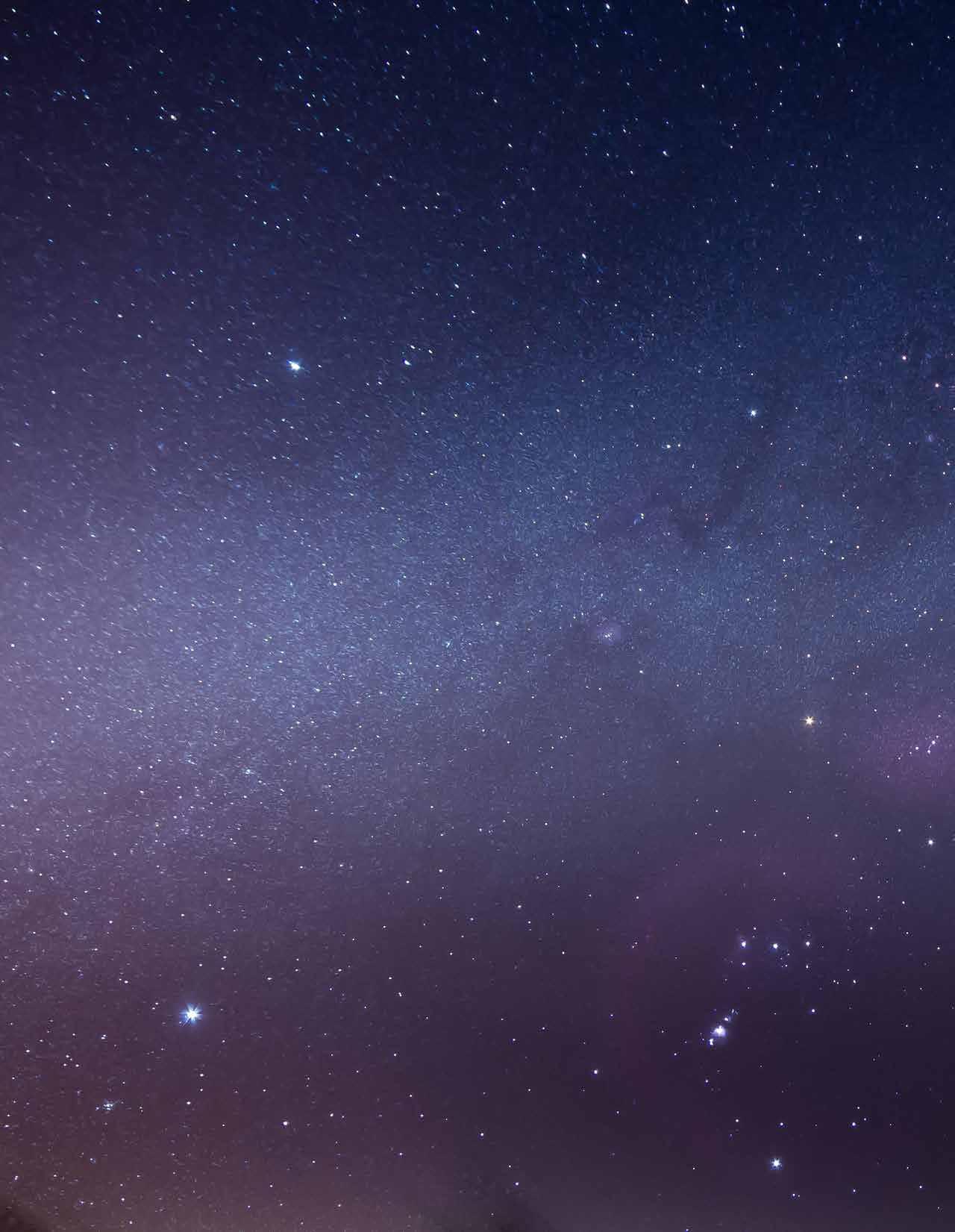
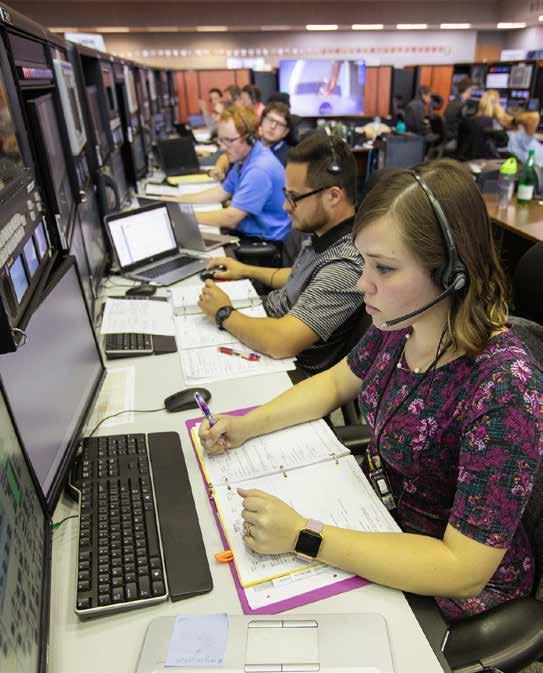
Launch Complex 39B
Teams will continue work on a new emergency egress system for Pad 39B where flight or ground crew could board a basket with a braking system at the crew access level of the mobile launcher. The crew would ride the basket down a cable and come to a stop near a bunker to the west of the pad surface, providing quick escape
A view looking up at the 10 levels of work platforms in High Bay 3 inside the Vehicle Assembly at NASA’s Kennedy Space Center in Florida. The work platforms will surround and provide access for service and processing of the agency’s Space Launch System rocket and Orion spacecraft for Artemis missions. Photo credit: NASA/Glenn Benson

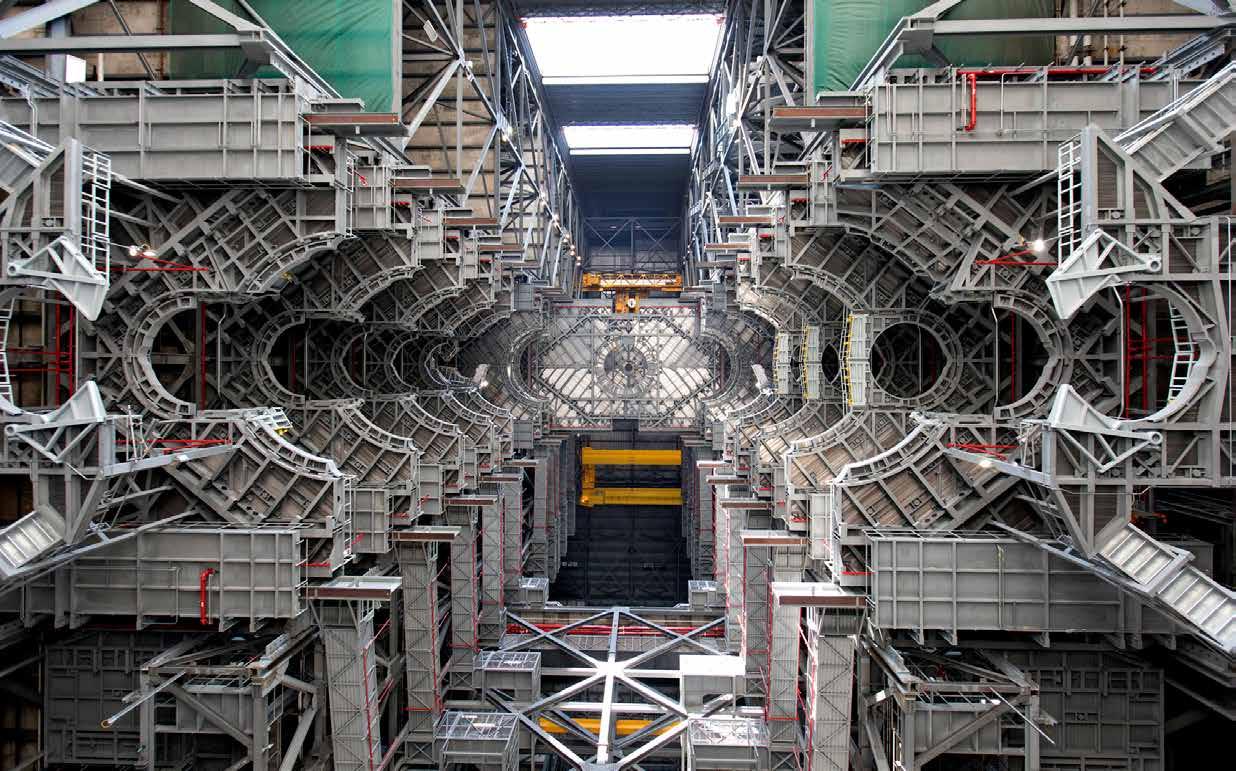
in the unlikely event of an emergency. The design phase began in 2019 and construction will be complete in time to support crewed Artemis missions.
The pad is currently getting a liquid hydrogen upgrade. The project involves the integration of a new 1.4 million gallon, liquid hydrogen (LH2) storage sphere into the existing Launch Complex 39B system. The new LH2 sphere will work with the current LH2 sphere to supply LH2 for Artemis II and beyond. The larger tank will allow NASA to attempt SLS launches on three consecutive days, instead of opportunities two out of three days, in the event of a scrub. The newer technology reduces liquid hydrogen burn-off, allowing more launch attempts before having to refill the larger tank. Construction began in 2019 and will be complete prior to Artemis II.
Orion Underway Recovery Test 8
The integrated recovery team of NASA, EGS, Lockheed Martin and the U.S. Navy, along with additional contractor support, will head out to sea off the coast of California in March to conduct the eighth Underway Recovery Test. Using a Navy ship with a well deck and several small boats, the primary objective is to validate Orion recovery operations for Artemis I — including procedures and timelines, and practicing different scenarios. Orion Spacecraft
This spring, the Orion spacecraft for Artemis I will return from NASA’s unique test facility at Plum Brook Station in Ohio, where it is currently undergoing environmental testing inside the vacuum chamber that simulates the harsh environment of space. Inside the Neil Armstrong Operations and Checkout (O&C) Building at Kennedy, technicians will install the spacecraft’s solar array wings before performing final checkouts. EGS will begin Orion ground processing and stacking activities later in the year. The team will process and fuel Orion in the Multi-Purpose Processing Facility then transfer it over to the Launch Abort System Facility where engineers will attach the launch abort system. Orion will then roll out to the VAB for inspections before stacking Orion on top of the SLS rocket.
In its early processing stages, the Artemis II crew module milestones inside the O&C include propulsion tank installation, a pressure test and subsystems installations in the spring. The initial power-on of the crew module will occur in early fall. The heat shield that will protect the first crewed mission of Orion will be completed and installed by the end of the year. Processing and testing of the crew module adapter – the ring that connects to the European Service Module – for Artemis II will happen in the first half of the year prior to the arrival of the European Service Module in the fall.
Build-up of a new liquid hydrogen (LH2) storage tank is in progress at Launch Complex 39B at NASA’s Kennedy Space Center in Florida. The new tank will hold 1.25 million gallons of usable LH2 to support future launches from the pad, including Artemis missions to the Moon and on to Mars. Photo credit: NASA/Cory Huston

Space Launch System
Training activities with pathfinders, or full-scale replicas, of the SLS core stage and booster segments occurred in 2019, and more training with various pathfinder segments and hardware will continue. In 2020, training will involve stacking inert booster segments on the mobile launcher in the VAB.
Hardware for SLS will continue to arrive for processing and integration in various Kennedy facilities. This year all ten of the solid propellant booster segments will arrive by train from their Northrop Grumman manufacturing facility in Promontory, Utah. The launch vehicle stage adapter, which will connect the SLS core stage to the interim cryogenic propulsion stage, will arrive by barge. The booster aft skirts – which contain the thrust vector control system that steers the rocket – will trek from the Booster Fabrication Facility to the Rotation, Processing and Surge Facility where they will be attached to the aft exit cones. The exit cones are attached to the bottommost part of each of the twin boosters to provide extra thrust to the boosters and protect the aft skirts from the thermal environment during launch. The core stage of the SLS rocket will undergo a Green Run test campaign over several months in the B-2 test stand at the agency’s Stennis Space Center in Mississippi. Following Green Run
completion, the 225,000-pound core stage will leave Stennis and arrive at Kennedy on the Pegasus barge. The core stage and solid rocket boosters will then be integrated inside the VAB.

Mobile Launcher 2
In 2019, NASA awarded a contract for Mobile Launcher 2 to Bechtel National Inc. of Reston, Virginia. The ground structure that will be used to assemble, process and launch the second and more powerful configuration of the SLS rocket, called Block 1B, is in its early stages of design and development and will be ready for Artemis IV.
Artemis I will be the first in a series of increasingly challenging missions that will enable human exploration to the Moon and Mars. In 2020, the mission will truly begin to take shape as hardware arrives and stacking operations begin inside the VAB.
“The operations team is writing procedures, training, and preparing for flight hardware processing,” Bolger said. “When the SLS and Orion are turned over to EGS later this year, Kennedy will be ready!”
Future Artemis missions will establish a sustainable presence at the Moon for decades to come, and Kennedy teams will move forward in 2020 to build the infrastructure and make those missions possible.
NASA’s mobile launcher, carried atop the crawlertransporter 2, returns to the Vehicle Assembly Building on Dec. 20, 2019, after spending months at Launch Pad 39B undergoing final validation and verification testing at the agency’s Kennedy Space Center in Florida. Photo credit: NASA/Ben Smegelsky


The Orion crew module for Artemis I is lifted by crane on July 16, 2019, in the high bay inside the Neil Armstrong Operations and Checkout Building at NASA’s Kennedy Space Center in Florida. The crew module was moved to the final assembly and test cell and work was completed to secure it atop the service module. Photo credit: NASA/Ben Smegelsky

Human Spaceflight Launches Returning to Kennedy Space Center

BY MARIE LEWIS NASA’s Commercial Crew Program will return human spaceflight capability to the United States in 2020, with the first crewed launches to the International Space Station from U.S. soil since the space shuttle’s retirement in 2011.
NASA and its commercial partners, Boeing and SpaceX, achieved significant progress in 2019 with the completion of SpaceX’s uncrewed Demo-1 mission, Boeing’s Pad Abort Test, and Boeing’s uncrewed Orbital Flight Test (OFT). SpaceX also completed its In-Flight Abort test in January 2020.
This spring, SpaceX is targeting its final flight test, known as Demo-2, which will carry NASA astronauts Bob Behnken and Doug Hurley to the space station aboard the Crew Dragon spacecraft and Falcon 9 rocket. The end-to-end flight test is planned to validate all aspects of SpaceX’s crew transportation system.
NASA and Boeing formed a joint, independent investigation team to examine the primary issues associated with the company’s uncrewed OFT, which did not dock to the space station as intended. The independent team will inform NASA and Boeing on the root cause of the mission elapsed timer anomaly and any other software issues and provide corrective actions needed before flying crew to the space station. The team will review the primary anomalies experienced during the December 2019 flight test, any potential contributing factors and provide recommendations to ensure a robust design for future missions.
In parallel, NASA is evaluating the data received during OFT to determine if another uncrewed demonstration is required. This decision is not expected for several weeks as teams take the necessary time for this review. NASA’s approach will be to determine if NASA and Boeing received enough data to validate the system’s overall performance, including launch, on-orbit operations, guidance, navigation and control, docking/undocking to the space station, reentry and landing. Although data from the uncrewed test is important for certification, it may not be the only way that Boeing is able to demonstrate its system’s full capabilities.
The start of a new decade also marks a new era in American human spaceflight. NASA is spurring economic growth in low-Earth orbit and working to open access to more people and more science than ever before. Upon successful NASA certification, Boeing and SpaceX are each slated to fly six crew missions to the space station continuing through 2024.
Commercial transportation to and from station will enable its expanded use, additional research time and broader opportunities of discovery aboard the orbiting laboratory. The station is critical for NASA to understand and overcome the challenges of long-duration spaceflight, and necessary for a sustainable presence on the Moon and missions deeper into the solar system, including Mars. These integrated spacecraft and launch vehicles will carry up to four astronauts at a time on NASA missions, with the goal of maintaining a crew of seven to maximize scientific research time on the orbiting laboratory.
As we turn over low-Earth orbit to commercial companies, we are preparing to explore the Moon and Mars – and commercial companies, like Boeing and SpaceX, will join us on that journey.
A two-stage SpaceX Falcon 9 rocket lifts off from Launch Complex 39A at NASA’s Kennedy Space Center for Demo-1, the first uncrewed mission of the agency’s Commercial Crew Program. Liftoff was at 2:49 a.m., March 2, 2019. The SpaceX Crew Dragon’s trip to the International Space Station was designed to validate end-to-end systems and capabilities, leading to certification to fly crew. Photo credit: NASA/Kim Shiflett
A two-stage SpaceX Falcon 9 rocket lifts off from Launch Complex 39A at NASA’s Kennedy Space Center for Demo-1, the first uncrewed mission of the agency’s Commercial Crew Program. Liftoff was at 2:49 a.m., March 2, 2019. The SpaceX Crew Dragon’s trip to the International Space Station was designed to validate end-to-end systems and capabilities, leading to
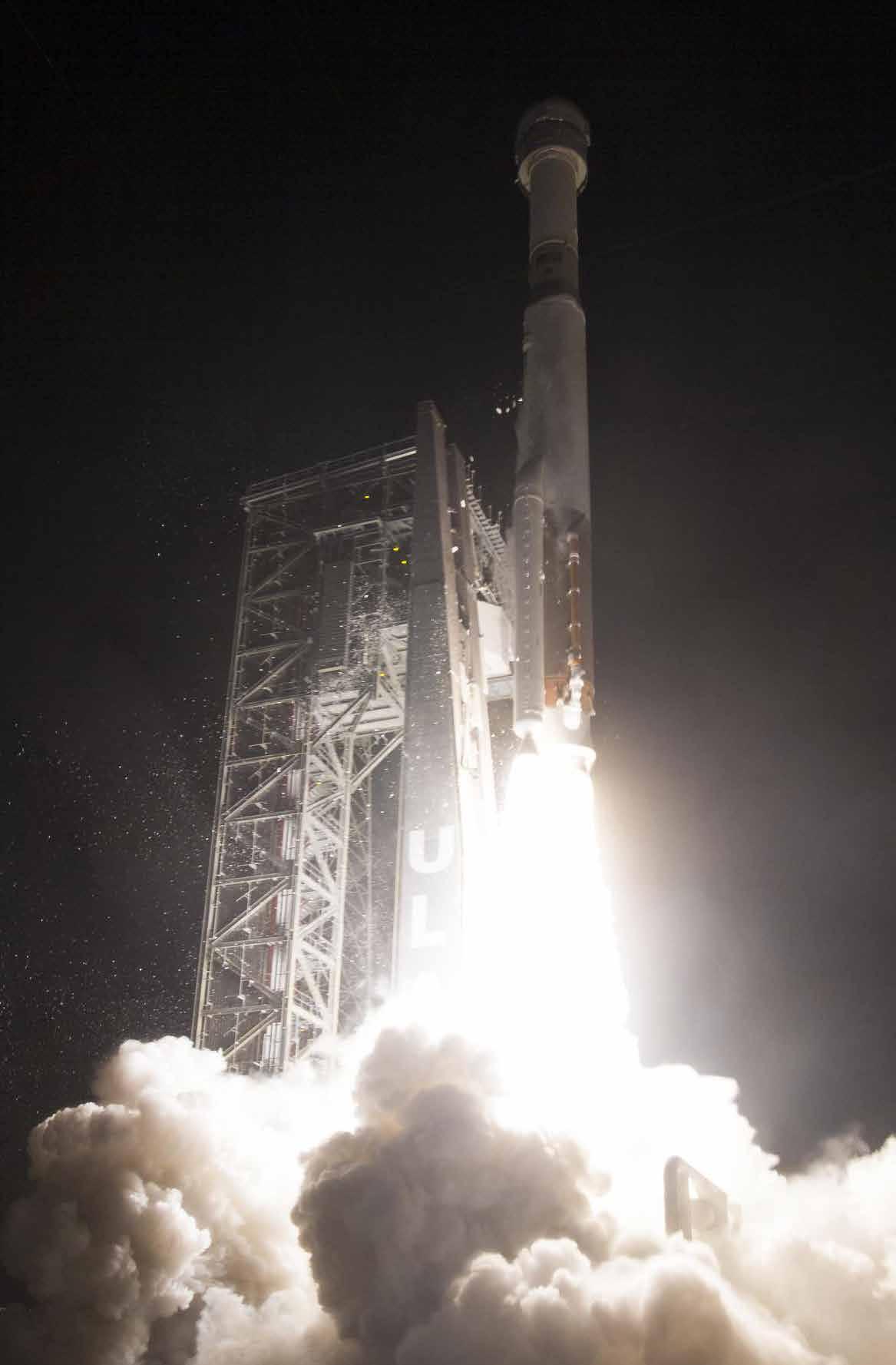

A United Launch Alliance Atlas V rocket with Boeing’s CST-100 Starliner spacecraft launches from Space Launch Complex 41 on Dec. 20, 2019. Launch was at 6:36 a.m. EST, from Space Launch Complex 41 at Cape Canaveral Air Force Station in Florida. Photo credit: NASA/Joel Koswky
NASA’s Launch Services Program Prepares for Upcoming 2020 Missions
BY DANIELLE SEMPSROTT
NASA’s Launch Services Program (LSP) is ringing in the New Year with three planned science missions in 2020, aimed at studying the Sun, Mars and our oceans. The first two missions will be launching from Cape Canaveral Air Force Station in Florida, while the third will launch from Vandenberg Air Force Base in California. Launching in February, Solar Orbiter is a collaborative mission between the European Space Agency (ESA) and NASA, which will study the Sun, its outer atmosphere and the solar wind. The spacecraft, developed by Airbus Defence and Space, will provide the first-ever images of the Sun’s poles. The Solar Orbiter spacecraft will launch aboard a United Launch Alliance (ULA) Atlas V 411 rocket, and liftoff is scheduled for Feb. 5. LSP will manage the launch. NASA’s Mars 2020 mission is targeting to launch in July. Established under the agency’s Mars Exploration Program, the mission will send a rover to the Red Planet to search for signs of ancient microbial life. It also will help us better understand the planet’s geology, collect rock and soil samples that can later be returned to Earth and test new technologies that could pave the way for future human exploration of Mars.
The rover is being manufactured at the agency’s Jet Propulsion Laboratory in California and will be sent to NASA’s Kennedy Space Center in mid-February. The rover will launch on a ULA Atlas V 541 rocket, procured by LSP, and is expected to land on Mars on Feb. 18, 2021.


Sentinel-6 Michael Freilich, the final mission of 2020, is projected to launch later in the year and will observe global sea level changes. The mission – a collaboration between ESA and NASA – aims to collect high-precision ocean altimetry measurements using two consecutive and identical satellites. The Sentinel-6 mission will launch from California on a SpaceX Falcon 9 rocket.
“LSP is incredibly excited to execute the 2020 launch manifest,” said Tim Dunn, LSP launch director. “Additionally, LSP will provide advisory expertise for four Commercial Crew Program missions and four Commercial Resupply Services program missions – all in support of the International Space Station. Also, throughout the year, LSP will be launching numerous CubeSat missions, focused on making space accessible to educational institutions.”
An artist’s concept of NASA’s Mars 2020 rover exploring the Red Planet. Image credit: NASA
Both halves of a United Launch Alliance Atlas V payload fairing are positioned for installation around the Solar Orbiter spacecraft inside the Astrotech Space Operations facility in Titusville, Florida, on Jan. 20, 2020. The fairing provides a protective, aerodynamic covering to the payload inside during the early minutes of ascent. Solar Orbiter launched aboard the Atlas V rocket from Space Launch Complex 41 at Cape Canaveral Air Force Station in Florida. Liftoff occurred at 11:03 p.m. EST on Feb. 9, 2020. Photo credit: NASA/Ben Smegelsky

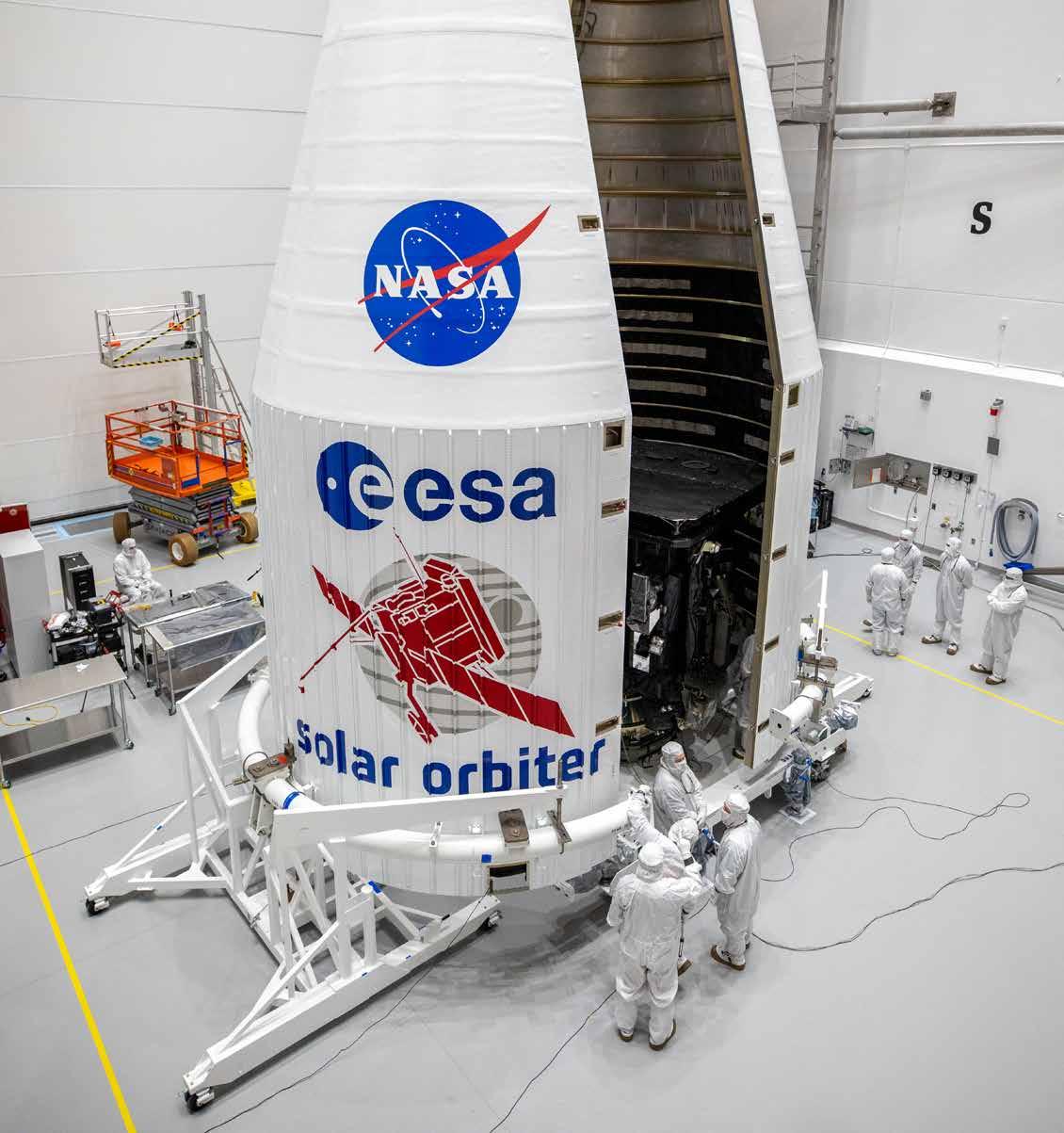
NASA Ready to Push Exploration Farther Than Ever in the New Year
BY LEEJAY LOCKHART
The Exploration Research and Technology (ER&T) programs at NASA’s Kennedy Space Center in Florida is a unique resource for the multi-user spaceport, supporting operations and technology development that will eventually allow humanity to explore farther into deep space than ever before.
November 2, 2020, will mark 20 years of human occupation on the International Space Station, and throughout this year ER&T plans to enable science research done on the space station with payload processing and logistic support of the orbiting laboratory. Collaborating with NASA’s partners, including commercial companies and international partners, ER&T will fulfill the goal of increased commercialization of the space station, which will add to the growing activity in low-Earth orbit, while still supporting governmental roles.
Developing technologies that allow explorers to live off the land contributes to the sustainable exploration of the Moon and eventually Mars, and in 2020, ER&T has several important biological experiments planned for the year to enable sustained exploration. Plants including radishes, amara mustard and peppers will fly to the station this year for testing and these experiments will use a combination of the Advanced Plant Habitat and Veggie

growth chambers for this new plant research. While astronauts have grown and consumed red romaine lettuce on the station before, in 2020 the growth chamber will test out a new technology called seed film, which is a water-soluble, dissolving film that will allow astronauts to plant seeds after the seeds arrive on station. Several other previously grown plant species also will be part of experiments on the station. These scientific investigations improve the technology development happening at Kennedy and supports NASA’s efforts to expand the frontier of knowledge, capability and opportunity in space.
An important mission for ER&T is taking emerging technologies and furthering their development with the ultimate goal being to infuse the technology into future missions. In 2020, much of this technology development will support NASA’s efforts to land the first woman and next man on the Moon’s surface as part of the Artemis program and return launches of astronauts to American soil as part of the Commercial Crew program.
These projects are solving a wide range of issues explorers will face in the coming years. By using the crushed rocks and dust that covers the surface of the Moon, called regolith, then melting it and using electrolysis, one ER&T investigation hopes to advance
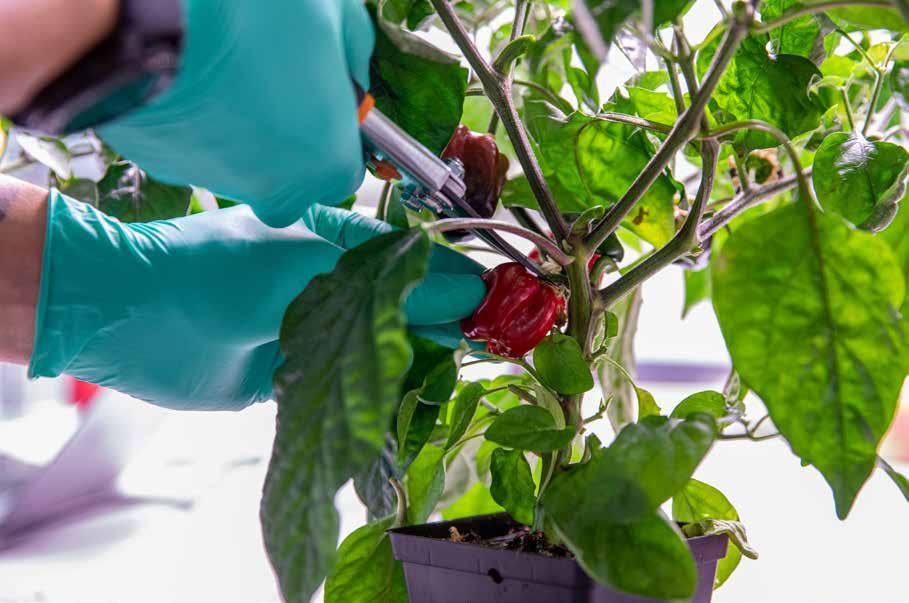
Inside the Space Station Processing Facility at NASA’s Kennedy Space Center in Florida, peppers are harvested on Jan. 15, 2020, for a growth assessment. The peppers were grown here on Earth under similar conditions found in space to determine how well the crop can grow. Research scientists waited until the peppers were red, or nearly all red, before harvesting them for the test. As we prepare to send humans beyond low-Earth orbit, the ability for astronauts to grow a variety of fresh fruits and vegetables in space will be critical. Ultimately, fresh produce will be an essential supplement to the crew’s pre-packaged diet, prepping them for long-duration space exploration. Photo credit: NASA/Ben Smegelsky
Janine Captain, principal investigator for the Mass Spectrometer observing lunar operations (MSolo), attaches a mass spectrometer sensor to a test rig at NASA’s Glenn Research Center in Cleveland, Ohio. MSolo is slated to fly to the Moon as part of NASA’s Commercial Lunar Payload Services. One of the missions will send a mobile robot named the Volatiles Investigating Polar Exploration Rover (VIPER) to the Moon to prospect for water. Photo credit: NASA/Glenn Research Center

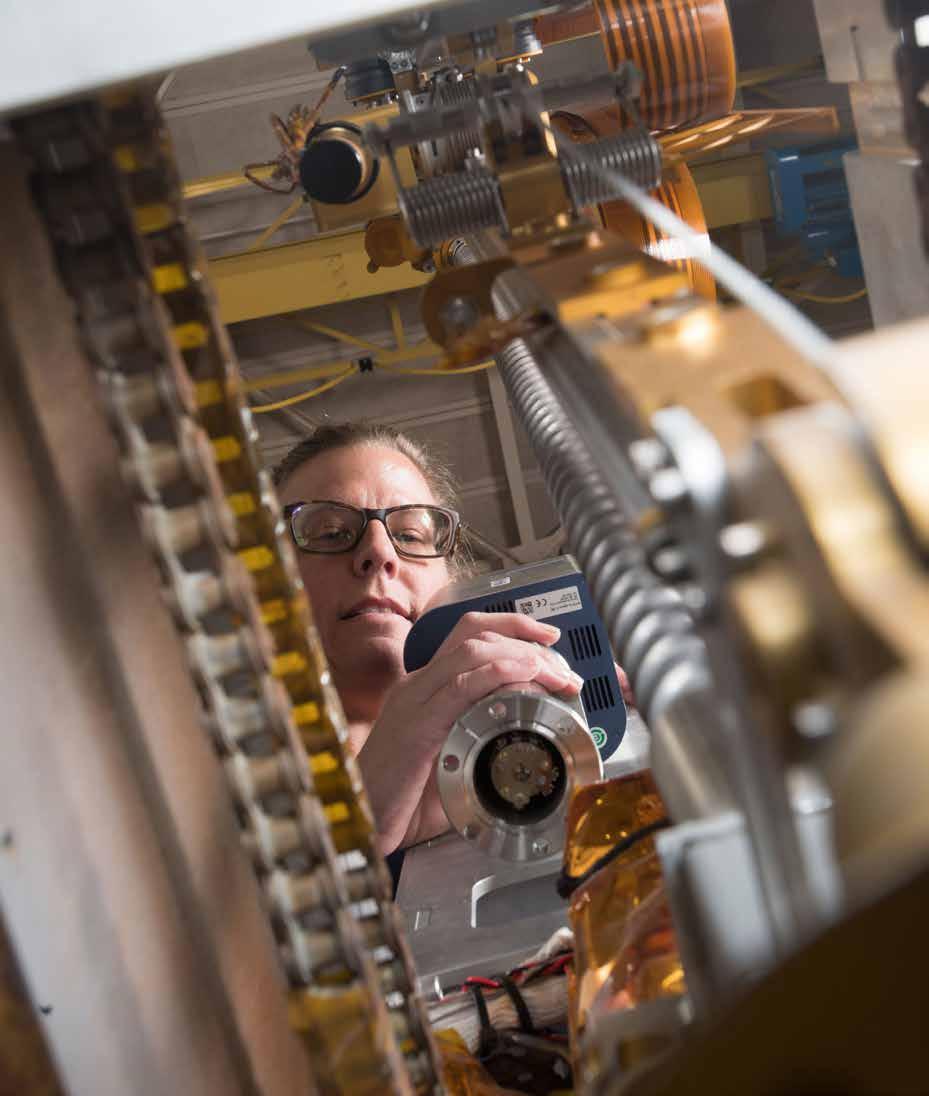
technology for producing oxygen for space explorers, which also could produce metals as a byproduct. Another project will examine using resources found on the Moon to build infrastructure such as landing pads to mitigate the effects of rocket plumes at landing sites.
For the first time since the Apollo era, the Artemis program is developing a human lunar lander, and ER&T is working to support operations on the lunar surface. ER&T also is working on projects related to the Commercial Lunar Payload Services, like the Mass Spectrometer observing lunar operations (MSolo). The sensor will be on future landers and lunar rovers and has the ability to measure resources that readily turn into a liquid or a gas, including water, when it arrives on the Moon. Using an off-the-shelf resource and working with a commercial partner has led to products capable of meeting NASA’s exploration requirements, while giving the commercial partner information that it can use to improve their products, enabling exploration through expertise and innovation.

On Dec. 11, 2019, OSCAR reached a major milestone when it launched on Blue Origin’s New Shepard rocket. This suborbital flight added valuable OSCAR microgravity performance data to previously collected data from lab and drop tests. This was the first full-stack payload launched on a Blue Origin rocket, which means it was bigger than previous payloads giving OSCAR the space it needed to conduct its flight test. Photo credit: Blue Origin
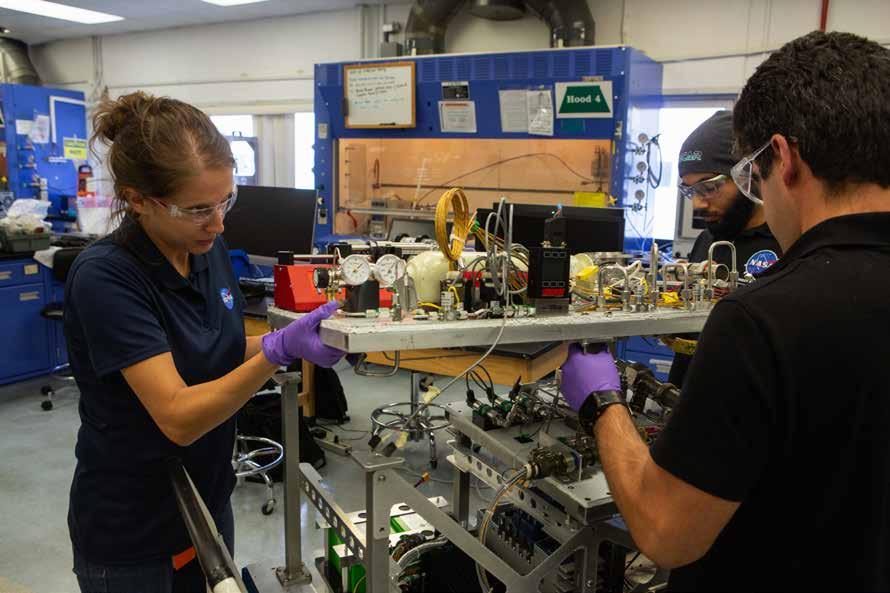
From left, team members Annie Meier, Malay Shah and Jamie Toro assemble the flight hardware for NASA’s Orbital Syngas Commodity Augmentation Reactor (OSCAR) on Oct. 10, 2019, in the Space Station Processing Facility at the agency’s Kennedy Space Center. Photo credit: NASA/Cory Huston
OSCAR Launches on Blue Origin New Shepard Rocket

On Dec. 11, 2019, NASA’s Orbital Syngas Commodity Augmentation Reactor (OSCAR) reached a major milestone when it launched on Blue Origin’s New Shepard rocket on NS-12 from the company’s West Texas launch site in Van Horn. This suborbital flight added valuable OSCAR performance data to data from previous lab and drop tests, which will help guide future development of the technology. This was the first full-stack payload launched on a Blue Origin rocket, which means it was bigger than previous payloads giving OSCAR the space it needed to conduct its flight test.
OSCAR experienced microgravity for several minutes in Blue Origin’s capsule as the spacecraft descended to Earth, deploying its parachutes and landing in Texas.
OSCAR has a prototype reactor that it uses to turn things like food packaging, old clothing and even human waste into water and a mixture of gases that is primarily carbon dioxide with small amounts of hydrogen, carbon monoxide and methane. While in microgravity, OSCAR successfully turned trash into gas and is one of several logistics reduction technologies NASA is investigating that could be useful for long-duration space exploration.




